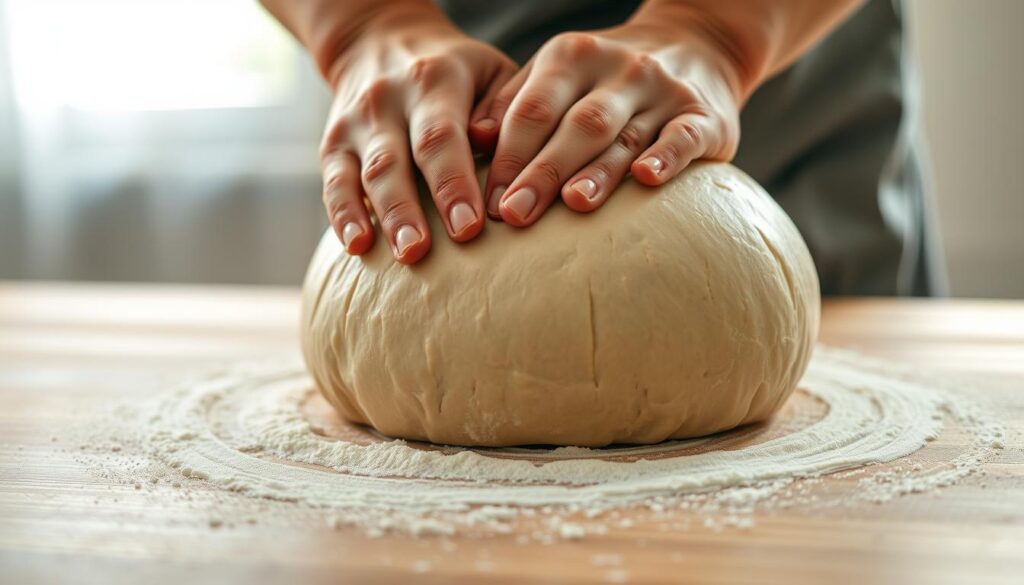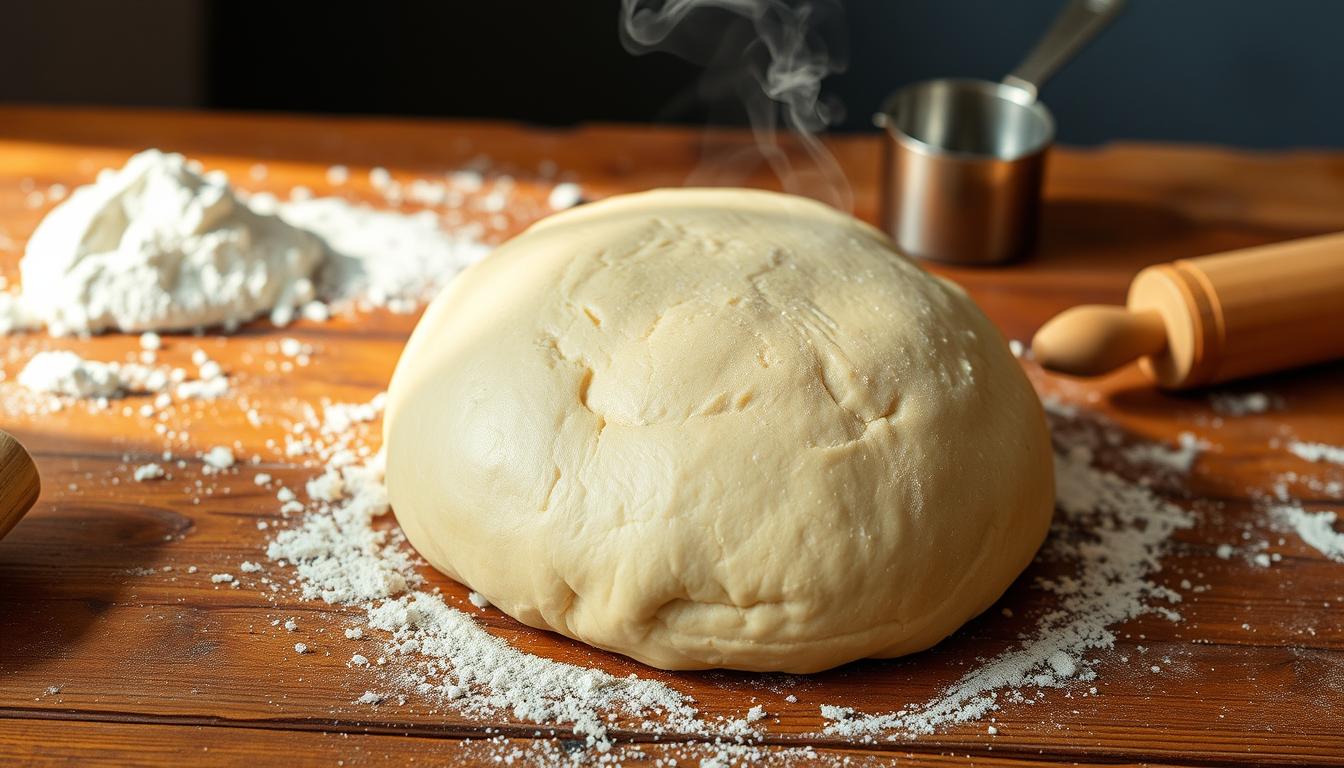Easy Steps to Make Bread Dough at Home
Can you imagine having freshly baked homemade bread straight from your oven, without the hassle of going to the bakery? Making bread dough at home is simpler than you think, and with just a few pantry staples, you can create delicious bread that rivals any bakery.
Using just flour, yeast, and a few other simple ingredients, you can create a perfect loaf for sandwiches or toast. Not only is making homemade bread cost-effective, but it also allows you to control the ingredients that go into your family’s food.
Key Takeaways
- Learn the simple steps to make bread dough at home.
- Understand the basic ingredients needed for homemade bread.
- Discover the benefits of making bread from scratch.
- Get tips on how to create perfect bread dough every time.
- Explore the advantages of using fresh yeast in your recipe.
The Basics of Bread Dough
Understanding the basics of bread dough is essential for anyone looking to bake bread at home. At its core, bread dough is a mixture of flour, water, yeast, and salt that transforms through fermentation into a versatile base for various bread types.
Why Make Bread Dough at Home
Making bread dough at home gives you complete control over the ingredients, allowing you to avoid preservatives and additives found in store-bought bread. By choosing your own ingredients, you can create bread that suits your dietary needs and preferences. Additionally, homemade bread dough can be more cost-effective and rewarding.
The benefits of making bread dough at home include:
- Control over ingredients and their quality
- Avoidance of preservatives and additives
- Flexibility to create various bread types
- Cost-effectiveness
Understanding the Science Behind Bread Dough
The science of bread making involves understanding gluten development, yeast fermentation, and how these processes create the structure and flavor of your bread. Gluten development is crucial for the dough’s elasticity and texture, while yeast fermentation is responsible for the rise and flavor of the bread.
| Process | Description | Impact on Bread |
|---|---|---|
| Gluten Development | Formation of gluten strands | Elasticity and texture |
| Yeast Fermentation | Conversion of sugars into CO2 | Rise and flavor |
By understanding these fundamental processes, you can improve your bread making skills and achieve better results.
Essential Ingredients for Homemade Bread Dough
Selecting the right ingredients is crucial for making delicious homemade bread. The quality of your bread dough depends on the ingredients you choose, and understanding their roles will help you create better bread.
Flour Options for Bread Making
The foundation of any good bread dough starts with the right flour. You can use either bread flour or all-purpose flour. Bread flour has a higher protein content, which creates a stronger gluten network, ideal for chewier breads. All-purpose flour, on the other hand, works well for softer breads. You can also experiment with whole wheat flour for added nutrition and flavor.
Types of Yeast and Their Properties
Yeast is a critical ingredient in bread making, responsible for fermentation. There are different types of yeast, including active dry, instant, and fresh yeast. Understanding their properties and handling requirements is crucial for achieving the right rise and flavor in your bread.
Additional Ingredients: Salt, Sugar, and Fat
Salt enhances flavor, strengthens gluten structure, and controls yeast activity. Sugar or honey serves as food for yeast, contributing to browning and flavor development. Fat, such as oil or butter, enriches the dough, creating a softer texture and enhanced flavor profile.
Optional Ingredients for Enhanced Flavor and Texture
You can further enhance your bread dough with optional ingredients like eggs, milk, butter, or oils. These additions can create a softer texture and more complex flavor profiles. Experimenting with different combinations can help you develop unique bread recipes.
When making bread dough, it’s also important to consider the temperature of the water. Water that is too hot can kill the yeast, while water that is too cold can slow down fermentation. Finding the right balance is key to successful bread making.
Equipment You’ll Need
You don’t need a lot of fancy equipment to make bread dough, but some basics are necessary. At its most basic, making bread dough at home requires minimal equipment.
Basic Tools for Hand Mixing and Kneading
For hand mixing and kneading, you’ll need a large mixing bowl, measuring cups and spoons, and a clean work surface. A dough scraper is also helpful for managing sticky dough and cleaning your work surface. Additionally, a kitchen scale ensures precise measurements for consistent results.

Stand Mixers and Bread Machines
If you have a stand mixer with a dough hook attachment, it can significantly reduce the physical effort required for kneading dough. While not necessary, a stand mixer makes the process easier. Alternatively, bread machines offer convenience by handling the entire dough-making process from mixing to the first rise.
Some specialized tools can enhance your bread making experience, though they’re not essential for beginners. These include proofing baskets, bread lames for scoring, and baking stones. A digital thermometer is also useful for ensuring your water is at the optimal temperature for activating yeast.
How to Make Bread Dough at Home
Creating your own bread dough from scratch can be a rewarding experience, and with the right guidance, it’s easier than you think. The process involves several key steps, from activating the yeast to kneading the dough to the right consistency.
Activating the Yeast
The first step in making bread dough is activating the yeast. To do this, you’ll need to combine active dry yeast with warm water (around 105-115°F) and a pinch of sugar in a large bowl. Let it rest for 5-10 minutes until it becomes foamy and bubbly. This step is crucial as it ensures your yeast is active and will help your dough rise.
Mixing the Ingredients
Once your yeast is activated, you can start mixing the ingredients. Combine the yeast mixture with the remaining sugar, salt, oil, and 3 cups of flour in a large bowl. Mix until just combined, then add another cup of flour and mix again. Gradually add more flour, ½ cup at a time, until the dough begins to pull away from the sides of the bowl. The total amount of flour needed may vary depending on the humidity and type of flour used.
Kneading Techniques
Kneading is a critical step in developing the gluten in your dough, which gives bread its structure. You can knead using a stand mixer with a dough hook attachment for about 5 minutes on medium speed, or by hand on a lightly floured surface for 5-8 minutes. The goal is to achieve a smooth, elastic consistency. If kneading by hand, be prepared to put in some effort, as this can be physically demanding.
Testing for Proper Gluten Development
To check if your dough has been kneaded enough, perform the windowpane test. Take a small piece of dough and stretch it between your fingers. If it forms a thin, translucent “windowpane” without tearing, the gluten is properly developed. If not, continue kneading and test again after a few more minutes. Proper gluten development is key to a well-structured loaf.
Throughout the mixing and kneading process, pay attention to the dough’s consistency. If it’s too sticky, add a little more flour, but be cautious not to add too much, as this can result in dense bread. The entire process should take about 15-20 minutes, with the dough temperature ideally reaching around 75-78°F by the end.
The Rising Process
As you embark on the bread-making journey, understanding the rising process is crucial for achieving the perfect loaf. The rising process involves several stages that are critical for developing the dough’s texture and flavor.
First Rise (Bulk Fermentation)
The first rise, also known as bulk fermentation, is a period when yeast creates carbon dioxide gas that gets trapped in the dough’s gluten network, causing it to expand and develop flavor. To facilitate this process, grease a large bowl with oil or cooking spray and place the dough inside. Cover it with a dish towel or plastic wrap and allow it to rise in a warm place until it has doubled in size, which typically takes about 1½ hours.
For optimal rising, maintain a warm environment with a temperature between 75-85°F. You can check if the dough has risen properly by performing the “finger poke test”: press a finger about ½ inch into the dough; if the indentation remains but slowly starts to fill back in, the dough is ready.
Punching Down the Dough
After the first rise, punching down the dough is essential. This step releases excess carbon dioxide and redistributes yeast cells, temperature, and food within the dough for more even fermentation. It’s a simple yet crucial step that ensures your bread develops a consistent texture.
Second Rise (Proofing)
The second rise, or proofing, occurs after shaping the dough and typically takes 30-60 minutes. During this time, the dough should rise until it reaches about 80-90% of its final volume before bread baking. Temperature significantly affects the rising time, with warmer environments speeding up the process and cooler temperature slowing it down.
| Rising Stage | Time | Temperature |
|---|---|---|
| First Rise | 1-1.5 hours | 75-85°F |
| Second Rise | 30-60 minutes | 75-85°F |
Shaping Your Bread Dough
Shaping your dough is where your bread starts to take shape, literally. Proper shaping is crucial for both the appearance and structure of your bread, creating the framework that determines how your loaf will rise and its final texture.
Basic Loaf Shaping
For basic sandwich loaves, you will need to divide your dough into equal portions. Shape each into a tight ball, then flatten into a rectangle and roll tightly from the short end, pinching the seam closed before placing in a greased loaf pan. This technique helps create a smooth, even surface and a well-structured loaf.

Shaping Rolls and Buns
When shaping rolls and buns, divide the dough into equal-sized pieces. Using a kitchen scale can help ensure uniformity. Shape each piece into tight balls by pulling the edges toward the bottom, and place them on a baking sheet with enough space between them to expand during the second rise.
Creating Artisan Bread Shapes
Creating artisan bread shapes like boules, batards, or baguettes requires building surface tension by folding the dough and dragging it across an unfloured surface. This technique helps develop the characteristic crust and texture of artisan breads.
| Bread Type | Shaping Technique | Final Texture |
|---|---|---|
| Basic Loaf | Rolling and pinching | Soft and even |
| Rolls and Buns | Shaping into balls | Soft and fluffy |
| Artisan Bread | Folding and dragging | Crusty and chewy |
After shaping, your dough will need a final rise (proofing) before baking, typically until the loaves have visibly expanded and feel light and airy. By following these shaping techniques, you can create a variety of bread types with different textures and appearances.
Troubleshooting Common Bread Dough Problems
Even experienced bakers encounter issues with bread dough, but knowing how to troubleshoot can make all the difference. Whether you’re struggling with dough that’s too sticky or too dry, or bread that doesn’t rise properly, understanding the causes and solutions can help you achieve better results.
Dough Too Sticky or Too Dry
One of the most common issues with bread dough is its consistency. If your dough is too sticky, it’s likely because it contains too much water or not enough flour. To fix this, you can add flour a tablespoon at a time during kneading until the dough reaches the right texture. On the other hand, if your dough is too dry, it may be due to insufficient water or too much flour. In this case, you can add water a teaspoon at a time until the dough feels tacky but not sticky. The ideal dough texture should be smooth and elastic, pulling away from the sides of the bowl while still feeling slightly tacky to the touch.
Dough Not Rising Properly
When your dough fails to rise properly, it can be due to several factors. The most common culprits are expired yeast, liquid that’s too hot (which can kill the yeast), or an environment that’s too cold. To avoid this issue, make sure your yeast is fresh and store it in the refrigerator to maintain its quality. Additionally, ensure that your ingredients are at the right temperature, and your dough is in a warm, draft-free place.
Fixing Dense or Heavy Bread
Dense, heavy bread can result from several factors, including insufficient rising time, under-kneading (not enough gluten development), or adding too much flour during the kneading process. To fix this, you can try increasing the hydration of your dough, extending the kneading time, or allowing for a longer rise to develop more gas bubbles in the dough. It’s also important to note that factors like altitude and humidity can significantly affect bread making, so adjustments may be necessary depending on your environment.
- If your dough is too sticky, add flour a tablespoon at a time during kneading.
- If your dough is too dry, add water a teaspoon at a time until it feels tacky but not sticky.
- Ensure your yeast is fresh and stored properly to help your dough rise.
By understanding and addressing these common bread dough problems, you can improve your baking skills and achieve better results. Remember, the key to successful bread making lies in the details, from the quality of your ingredients to the conditions in which your dough rises.
Variations and Creative Uses for Your Bread Dough
Having a solid foundation in bread dough making enables you to explore a multitude of bread variations. With a basic bread recipe, you can create a wide range of delicious breads by incorporating different ingredients and shaping techniques.
Sweet Bread Variations
Sweet breads are a delightful treat. You can make cinnamon swirl bread by rolling out the dough, spreading it with a mixture of sugar and cinnamon, and then rolling it into a log. Adding dried fruits, nuts, and spices to the dough can also create flavorful sweet breads.
Savory Bread Options
For savory options, you can incorporate herbs, cheeses, garlic, olives, or sun-dried tomatoes into your bread recipe to create flavorful accompaniments to meals. Experimenting with different ingredients can help you develop unique savory breads.
Using Bread Dough for Pizza and Flatbreads
The same basic dough can be transformed into pizza bases or flatbreads by adjusting the hydration slightly and changing the shaping and baking methods. Using whole wheat flour can add nutrition and texture to your pizzas and flatbreads.
By experimenting with different flour blends and adding enrichments like butter, eggs, or milk to your dough, you can create softer, more tender bread with a longer shelf life. This versatility allows you to adapt your basic bread recipe for various needs and preferences.
Storing and Freezing Bread Dough
Proper storage is key to maintaining the freshness of your homemade bread. Once your loaf has cooled, you can store it in an airtight container or bag at room temperature for 2-3 days. If you need to store it longer, you can refrigerate it for up to 5 days, though be aware that refrigeration can accelerate staling.
For longer-term storage, freezing is an excellent option. You can freeze both bread dough and baked loaves. To freeze dough, prepare it through the shaping stage, then place the shaped loaves in a freezer-safe pan, cover with aluminum foil, and freeze for up to 3 months. To bake, thaw overnight in the refrigerator and let it rise at room temperature before baking.
Brushing the crust with butter after baking not only adds flavor but also helps keep the crust soft by adding a protective layer of fat. When storing or freezing, make sure to label your bread or dough with the date and type to keep track of what’s in your freezer.







